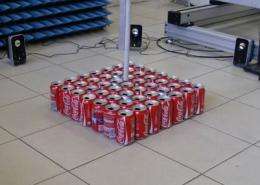July 12, 2011 report
Coke cans focus sound waves beyond the diffraction limit

(PhysOrg.com) -- When trying to focus sound waves into as small an area as possible, scientists run into a fundamental limit called the diffraction limit. That is, when sound waves are focused into a region smaller than one wavelength, the waves begin to bend and spread out. Recently, scientists have designed complex acoustic metamaterial lenses in an attempt to overcome the diffraction limit, but now a new study shows that this can be done using much simpler materials - specifically, 49 empty Coke cans.
To build the acoustic lens, physicists Geoffroy Lerosey, Fabrice Lemoult, and Mathias Fink at the Langevin Institute of Waves and Images at the Graduate School of Industrial Physics and Chemistry in Paris (ESPCI ParisTech) assembled a 7x7 array of empty Coke cans with the tabs pulled off.
Then, the scientists surrounded the Coke can array with eight computer speakers. When they turned the speakers on to play a single tone, the sound waves traveled around and inside the cans, causing the cans to collectively oscillate like organ pipes. As a whole, the lens generated a variety of resonance patterns, some of which emanated from the can openings, which are much smaller than the wavelength of the sound waves.
The small waves are similar to evanescent waves, which can reveal details smaller than a wavelength and be used to focus sound. If researchers can capture evanescent waves, they can beat the diffraction limit. However, evanescent waves only exist very close to an object’s surface because they fade very quickly, making them difficult to capture. Previously, scientists have used acoustic metamaterial lenses to amplify the evanescent waves in order to make them easier to capture.
Here, the researchers figured out a way to amplify and capture the evanescent-like waves coming from the soda cans using a method called “time reversal.” They recorded the sound above a single can with a microphone, and then played this sound backwards through the speakers. The resulting sound waves amplify the sound above the can from which the original sound came from, and cancel out the sound everywhere else.
As this single can continues to resonate, sound waves inside the can become scattered. While the normal sound waves scatter and disappear quickly, the evanescent-like waves take longer - about a second - to scatter out of the can. That’s enough time to allow the evanescent-like waves to build up into a highly focused spot of just a few centimeters, or about 1/25th the space of the meter-long wavelength of the original acoustic wave. Such focus is significantly beyond the diffraction limit.
"Without being too enthusiastic, I can say [our work] is the first experimental demonstration of far-field focusing of sound that beats the diffraction limit," Lerosey told Nature News. (Sub-wavelength focusing in the near field, where different wave behavior dominates, has already been demonstrated.)
By showing that a simple Coke can array can focus sound waves beyond the diffraction limit, the study could have applications in providing energy for tiny electromechanical devices, among other uses.
More information: F. Lemoult, et al. Physical Review Letters. To be published.
via: Nature News and Physics World
© 2010 PhysOrg.com


















